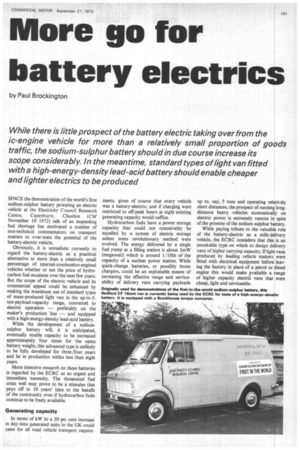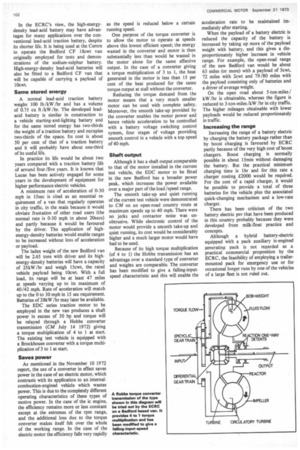More go for battery electrics
Page 103

Page 104

If you've noticed an error in this article please click here to report it so we can fix it.
While there is little prospect of the battery electric taking over from the ic-engine vehicle for more than a relatively small proportion of goods traffic, the sodium-sulphur battery should in due course increase its scope considerably. In the meantime, standard types of light van fitted with a high-energy-density lead-acid battery should enable cheaper and lighter electrics to be produced
by Paul Brockington
SINCE the demonstration of the world's first sodium-sulphur battery powering an electric vehicle at the Electricity Council Research Centre. Capcnhurst. Cheshire (CM November 10 1972) talk of an impending fuel shortage has motivated a number of non-technical commentators on transport matters to over-state the potential of the battery-electric vehicle.
Obviously, it is unrealistic currently to regard the battery-electric as a practical alternative to more than a relatively small percentage of internal-combustion-engined vehicles whether or not the price of hydrocarbon fuel escalates over the next few years. But the scope of the electric vehicle and its commercial appeal could be enhanced by making the maximum use of standard types of mass-produced light van in the up-to-5ton-payload-capacity range, converted to electric operation — preferably on the maker's production line — and equipped with a high-energy-density lead-acid battery.
While the development of a sodiumsulphur battery will, it is anticipated, eventually enable capacity to be increased approximately four times for the same battery weight, this advanced type is unlikely to be fully developed for three /four years and be in production within less than eight years.
More intensive research on these batteries is regarded by the ECRC as an urgent and immediate necessity. The threatened fuel crisis well may prove to be a stimulus that pays off in 10 years' time to the benefit of the community even if hydrocarbon fuels continue to be freely available.
Generating capacity
In terms of kW hr a 30 pc,cent increase in day time generated units in the UK could cater for all road vehicle transport require
ments, given of course that every vehicle was a battery-electric; and if charging were restricted to off-peak hours at night existing generating capacity would suffice.
Hydrocarbon fuels have a power storage capacity that could not conceivably be equalled by a system of electric storage unless some revolutionary method were evolved. The energy delivered by a single fuel pump at a filling station is about 3mW (megawatt) which is around 1 /10th of the capacity of a nuclear power station. While quick-change batteries, or possibly boost chargers, could be an exploitable means of increasing the effective range and serviceability of delivery vans carrying payloads up to, say, 5 tons and operating relatively short distances, the prospect of running longdistance heavy vehicles economically on electric power is extremely remote in spite of the promise of the sodium-sulphur battery.
While paying tribute to the valuable role of the battery-electric as a milk-delivery vehicle, the ECRC considers that this is an unsuitable type on which to design delivery vans of higher carrying capacity. If light vans produced by leading vehicle makers were fitted with electrical equipment before leaving the factory in place of a petrol or diesel engine this would make available a range of higher capacity electric vans that were cheap, light and serviceable. In the ECRC's view, the high-energydensity lead-acid battery may have advantages for many applications over the conventional lead-acid traction battery, despite its shorter life. It is being used at the Centre to operate the Bedford CF 18cwt van originally employed for tests and demonstrations of the sodium-sulphur battery. High-energy-density lead-acid batteries will also be fitted to a Bedford CF van that will be capable of carrying a payload of lOcwt.
Same stored energy A normal lead-acid traction battery weighs 100 lb /kW /hr and has a volume of 0.75 cu ft /kW /hr. The developed leadacid battery is similar in construction to a vehicle starting-and-lighting battery and for the same stored energy has two-thirds the weight of a traction battery and occupies two-thirds of the space. Its cost is about 50 per cent of that of a traction battery and it will probably have about one-third of its useful life.
In practice its life would be about two years compared with a traction battery life of around four /five years. It is known that Lucas has been actively engaged for some years in the development of equipment for higher performance electric vehicles.
A minimum rate of acceleration of 0-30 mph in 15sec is cited as an essential requirement of a van that regularly operates in city traffic, in the main because it would obviate frustation of other road users (the normal rate is 0-30 mph in about 20secs) and partly because it would be favoured by the driver. The application of highenergy-density batteries would enable ranges to be increased without loss of acceleration or payload.
The laden weight of the new Bedford van will be 2.65 tons with driver and its highenergy-density batteries will have a capacity of 25kW /hr and weigh 15cwt, the rated vehicle payload being 10ewt. With a full load., its range will be at least 47 miles at speeds varying up to its maximum of 40/42 mph. Rate of acceleration will match up to the 0 to 30 mph in 15 sec requirement. Batteries of 28kW /hr may later be available.
The EDC series traction motor to be employed in the new van produces a shaft power in excess of 30 hp and torque will be relayed through a Hobbs converter transmission (CM July 14 1972) giving a torque multiplication of 4 to 1 at start. The existing test vehicle is equipped with a Brockhouse converter with a torque multiplication of 3 to 1 at start.
Saves power As mentioned in the November 10 1972 report, the use of a converter in effect saves power in the case of an electric motor, which contrasts with its application to an internalcombustion-engined vehicle which wastes power. This is due to the completely different operating characteristics of these types of motive power. In the case of the ic engine, the efficiency remains more or less constant except at the extremes of the rpm range, and the additional loss due to the torque converter makes itself felt over the whole of the working range. In the case of the electric motor the efficiency falls very rapidly as the speed is reduced below a certain running speed.
One purpose of the torque converter is to allow the motor to operate at speeds above this lowest efficient speed; the energy wasted in the converter and motor is then substantially less than would be wasted in the motor alone for the same effective output. In the case of a converter giving a torque multiplication of 3 to 1, the heat generated in the motor is less than 15 per cent of the heat produced for the same torque output at stall without the converter.
Reducing the torque demand from the motor means that a very much smaller motor can be used with complete safety. Moreover, the smooth take-up provided by the converter enables the motor power and hence vehicle acceleration to be controlled with a battery voltage switching control system, four stages of voltage providing smooth control in a vehicle with a top speed of 40 mph.
Shaft output Although it has a shaft output comparable to that of the motor installed in the current test vehicle, the EDC motor to be fitted in the new Bedford has a broader power peak. which increases the power available over a major part of the load /speed range.
The smooth take-up and quiet running of the current test vehicle were demonstrated to CM on an open-road country route at maximum speeds up to 40 mph. There were no jerks and contactor noise was unobtrusive. While electronic control of the motor would provide a smooth take-up and quiet running, its cost would be considerably higher and a much larger motor would have had to be used.
Because of its high torque multiplication (of 4 to I) the Hobbs transmission has an advantage over a standard type of converter and weights are comparable. The converter has been modified to give a falling-inputspeed characteristic and this will enable the acceleration rate to be maintained immediately after starting.
When the payload of a battery electric is reduced the capacity of the battery is increased by taking up more of the payload weight with battery, and this gives a disproportionately higher increase in vehicle range. For example, the open-road range of the new Bedford van would be about 63 miles (or more) with a payload of 5cwt,• 72 miles with 2ewt and 79/80 miles with the payload consisting only of batteries and a driver of average weight.
On the open road about 5-ton-miles/ kW /hr is obtainable, whereas the figure is reduced to 3-ton-miles /kW /hr in city traffic. The higher mileages obtainable with lower payloads would be reduced proportionately in traffic.
Increasing the range Increasing the range of a battery electric by charging the battery package rather than by boost charging is favoured by ECRC partly because of the very high cost of boost chargers. Boost charging is normally possible in about 15min without damaging the battery. But the practical minimum charging time is lhr and for this rate a charger costing £2000 would be required. For the cost of a rapid charger, it would be possible to provide a total of three batteries for the vehicle plus the associated quick-changing mechanism and a low-rate charger.
There has been criticism of the two battery electric psv that have been produced in this country probably because they were developed from milk-float practice and concepts.
Although a hybrid battery-electric equipped with a pack auxiliary ic-engined generating pack is not regarded as a practical commercial proposition by the ECRC, the feasibility of employing a trailermounted pack for emergency use or for occasional longer runs by one of the vehicles of a large fleet is not ruled out.
















































































































































































